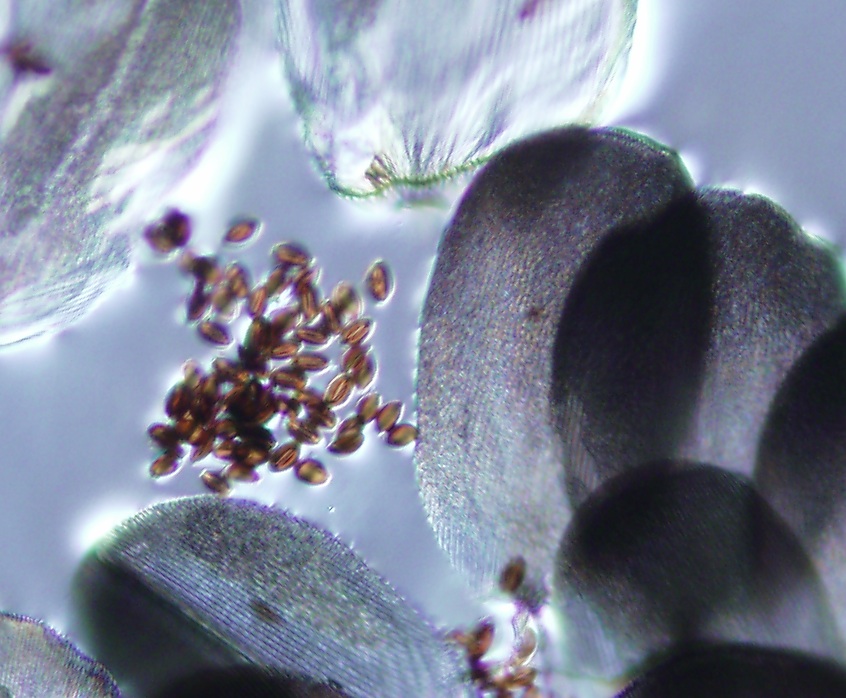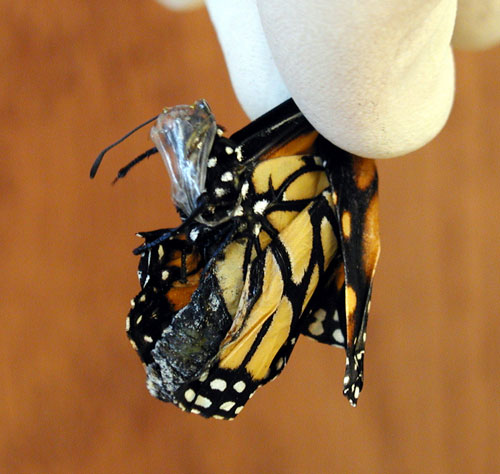NOTE: The following guest post by Dr. Barbara Dorf* arrived as a lengthy comment here at the Texas Butterfly Ranch last week. I invited Dorf to expand her comment to a full-blown post because I think the perspective of professional breeders is important to various issues discussed here.
–Monika Maeckle
As a board member of the Association for Butterflies, an organization for about 80 professional and hobbyist butterfly breeders and a co-owner of Big Tree Butterflies commercial butterfly breeding farm, I am writing today to clarify our position in relation to the proposed petition to the U.S Fish and Wildlife Service (USFWS) to list the Monarch butterfly as threatened or endangered under the Endangered Species Act (ESA).

Dr. Tracy Villareal and Dr. Barbara Dorf, owners of Big Tree Butterflies in Rockport, Texas –Courtesy photo
As stated in a recent post on this website, Lawsuit seeks ESA monarch butterfly listing, turns up heat on commercial breeders, the petitioners believe that commercial breeders release diseased butterflies into the wild population, potentially damaging it. Such comments oversimplify the butterfly industry and misrepresent the efforts of many breeders who are very diligent and dedicated to raising healthy butterflies.
Butterfly disease is a concern for all ethical butterfly breeders and part of the larger issue of raising healthy butterflies in captivity. Our concern is at several levels.
We want to raise healthy butterflies and provide customers with the best value for their money. In addition, butterflies are living creatures and proper animal care practices need to be observed. Failure to adopt clean rearing procedures is costly and ultimately self-destructive. That said, there are areas of concern.
Ophyryocystis elecktroscirrha, or OE, has been studied extensively and is of particular concern because it can significantly impact Monarch populations. It is the most commonly mentioned disease problem in both the butterfly industry and popular press. OE occurs in nature, primarily infecting Monarchs and related butterflies. It is found in Monarch butterfly populations throughout the world, including North and South America, the Caribbean, Hawaii, and Australia.

OE spores transfer through physical contact or consumption of milkweed leaves. Photo by Dr. Tracy Villareal
OE can be transmitted in two ways. In nature and during captive breeding, spores are transmitted from egg-laying females to their offspring when dormant spores on the female’s body scales are scattered on eggs or as they are passed onto milkweed leaves that are the Monarch’s only host plant. Newly emerged caterpillars consume spores when they eat their eggshell or when feeding on milkweed leaves. Spores can also be spread between adults through body contact, more likely to occur during captive breeding when adults are kept in higher concentrations than in the wild.
Once eaten, the spores have a rather complicated life cycle, with the end result being many more spores, which are often visible inside the chrysalis. When the butterfly emerges spores are located mostly on the abdomen.
OE can be debilitating, often killing or deforming caterpillars, chrysalises and adults. Infected adults have been shown to be smaller, have shorter lives, and mate and migrate less successfully. However, those that do mate can continue to lay eggs, passing on the OE spores to the next generation, both in nature and in captivity.

OE infected Monarchs can have trouble emerging from the chrysalis and may be deformed. Photo via UGA Monarch parasites website
If not controlled, all butterflies within a captive breeding colony will become infected with OE in very few generations, resulting in poor quality butterflies unable to successfully breed or migrate when released. This is a butterfly breeder’s worst nightmare.
Thus, the butterfly industry has a vested interest in producing OE-free butterflies and educating all breeders on how to produce healthy butterflies. The problem is not that all butterfly breeders raise and sell OE-contaminated Monarch butterflies. Rather, the problem is that customers cannot tell if the butterfly breeder they are purchasing from raises OE-free butterflies.
The AFB has been implementing programs over the last 10 years and has been anything but lethargic concerning OE in commercially raised butterflies.
Here is what the AFB is doing to address the problem:
1. Educational programs
The AFB offers educational programs developed by butterfly professionals and academic researchers available to anyone who wants to learn more about butterfly disease prevention.
Our annual “Disease Prevention in Lepidoptera” course (offered for the last 10 years!) is free to all members and has been taken by hundreds of professional breeders, hobbyists, enthusiasts and educators, and offers a Disease Seal and certification for participants who successfully complete weekly testing and a final exam.
2. Disease screening co-op
In addition to education, the AFB also offers its members a 3rd-party Disease Screening Co-op in conjunction with the Mississippi State Pathology Department. Caterpillars are screened by pathologists for viruses, bacteria and parasites, helping breeders to detect issues in breeding butterflies before disease can cause serious issues.
3. OE Clean Screen Program
The AFB has initiated the OE Clean Screen Program, a butterfly industry first. This is a 3rd-party OE testing program in which professional breeders voluntarily submit Monarch chrysalises to an independent University laboratory for OE testing when the adult butterfly emerges. Submitting fresh chrysalises eliminates any possibility of “selection” for OE-free 
butterflies. Acceptable OE levels reflect natural background levels, with 20% of all butterflies tested having either no OE or showing light contamination (less than 100 spores). The program was set up with comments and advice from Dr. Sonia Altizer, a leading Monarch butterfly researcher and world-expert on OE.
Testing is voluntary and anonymous. Breeders will receive a Clean Screen rating and be highlighted on the AFB website as part of a Preferred Listing. The rating indicates that the breeder has met standards for OE prevention that have been approved by academic researchers. No program with this level of rigor and independent evaluation has ever been attempted. This is a serious program to address a legitimate concern. It is open to all butterfly farmers, even if they do not belong to the AFB.
The purpose of this testing program is not to penalize breeders who may have OE-positive butterflies, but to get a better picture of the butterfly industry, offer support and education, troubleshoot, identify, and correct possible rearing problems, and to encourage all butterfly breeders to do a better job of keeping a clean operation. The result will be that customers will be able to compare butterfly breeders based on this independent standard. The marketplace will determine the rest. Independent, 3rd-party certification allows customers to know that the breeder was producing Clean Screen stock at the time and that they are taking an active interest in producing healthy butterflies. Thus, it is in the butterfly breeder’s best interest, once they have Clean Screen stock, to maintain them.
There are unscrupulous butterfly breeders out there who do not practice clean breeding techniques and give the entire butterfly industry an unfavorable image. Because these unscrupulous breeders exist, buying butterflies from breeders engaged in independent 3rd-party testing allows customers to know that they are buying from a butterfly breeder who is seriously working to produce healthy butterflies.
In closing, butterfly disease is a concern for all ethical butterfly breeders and the AFB is working hard to provide the best possible support to butterfly breeders for rearing healthy butterflies.
*When she’s not raising butterflies, Barbara Dorf works as a fishery biologist at Texas Parks and Wildlife. She earned her PhD in biological oceanography at the University of Rhode Island and holds undergraduate degrees in wildlife and fisheries science and aquatic biology.
Related posts:
- Lawsuit seeks ESA listing, turns up heat on commercial butterfly breeders
- How to raise Monarch butterflies at home, Part I
- Endangered Species Act: Wrong tool for the Job of Monarch butterfly Conservation?
- Tropical milkweed: Ok for Monarch Butterflies, “Just Cut the Dang Stuff Down”
- Monarch butterfly release “better than any church service
- What does climate change mean for Monarch butterflies?
- Monarch butterflies: the Panda Bears of Climate Change
- Persnickety Texas Native Milkweeds Pose Challenges for Growers
- Texas Butterfly Ranch Native Texas Milkweed Guide
- A Year in the Life of a Mostly Native Urban Butterfly Garden
Like what you’re reading? Follow butterfly and native plant news at the Texas Butterfly Ranch. Sign up for email delivery, like us on Facebook, or follow us on Twitter, @monikam.

I don’t understand why people are buying and selling butterflies in the first place! I gather this has nothing to do with science, but rather people’s desire to have them for weddings and such. Whether they are disease-free or not, These are living beings, not party favors!
You’re right, it has very little to do with some peoples’ science. Some of us enjoy butterflies so much we just like lots of them around all the time and want to help others enjoy them too. http://www.CraigTheButterflyman.com
I would not buy them for weddings and shame on those who do not caring that the monarchs released may contribute to the problem. We have a choice and can research to find reputable sellers only. That said, I would buy for my enjoyment and to help save the monarchs.
I agree with Grace’s email about the commercial sale of Monarch butterflies. I will no longer receive emails from this source as it is not focused on the survival and prosperity of the endangered Monarch butterfly. Rather it serves as an advertising site for commercial butterfly companies. I believe the sale of these beautiful creatures for entertainment or for any reason is cruel and unethical.
It is focused on survival of Monarchs by assuring that our sources are healthy. Many of us who have lost them to pesticides and disease want to do our part in helping them and the bees and birds make a comeback. Since I do not have any Monarchs now, my best chance to help is to reintroduce them to my area, healthy and free from disease, not more diseased ones who will contribute to the problem.
How can I find out if these spores have been deposited on milkweed in my yard? I have not had many Monarchs the last two years. I have saved seed from the common and reed milkweeds which grow in my area. Should I not save the seed, can it be contaminated?
In the event that the leaves of my plants are contaminated, how can I eliminate the spores on them? I live in Missouri, Lincoln county.
Good question for the scientists. We really haven’t gotten a good answer from them. Here’s a post about that: https://texasbutterflyranch.com/2015/11/24/guidance-on-milkweed-management-confuses-butterfly-gardeners/
Rather than diss Monika for allowing some perspective on the issue of commercial rearing of monarchs, I think folks should thank her for being honest in her treatment of the subject. All she’s done is allow a more nuanced understanding of a complicated subject. This is hardly an advertisement for the industry. It is more a wakeup call to farmers out there who may not have had the chance to learn about the types of assistance that is offered to them. The butterfly farming industry is not monolithic and there are those of us who really resent being lumped in with what are the butterfly equivalent of puppy mills.
I can appreciate that there are folks who do not like the idea of commercially rearing butterflies. That’s okay. It is a bit of stretch, though, to say our butterflies are “party favors.” We are not disrespectful to our butterflies at all. In fact, we do our best to insure that they are healthy and well-fed. We take great care when shipping them to insure they arrive alive and in very good condition. This is a well-established animal husbandry principle based on an ethical treatment of captive raised animals. People raise cats , dogs, horses, birds, fish, etc as pets or for service animals. I am very fond of Maine Coon cats and I am very glad there are breeders out there. The beneficial insect industry regularly raises and releases hundreds of thousands, perhaps millions of insects that are essential to the organic industry. They attack harmful insects and permit raising produce without use of pesticides. In my opinion, this is a good thing. All of these are fascinating and unique forms of life that have been enlisted to assist humans in some form of the other. To me, it does not make it evil, unethical, or tainted in some manner that butterflies are part of this larger picture.
All she did was to give a balanced view of the subject. There are reputable breeders out there and for me, it is welcome since I have seen a dramatic reduction of Monarchs in my area. Unfortunatly, I live on a bluff above farm fields whose owners continue to use Round Up and gmo seed. For me to be able to buy healthy monarchs will hopefully allow me to sit and watch monarchs. My wild milkweeds have gone all season long without chewed leaves which means no butterflies. Now all that is needed is to eliminate the breeders who are not ethical.
The last 2 posts are interesting to me. I live in Thousand Oaks California. I am 10 miles from Camarillo which is a farming community. If I don’t pluck my caterpillars at the 2nd inatar I will lose over 60% to the Tachinid Fly that the organic farmers buy. I clean my habitats as often as possible and feed cuttings only. I have done my own sorting from the different stages I remove the caterpillars from the plant. If they are at 5th instar I will lose 90% to the fly. We released over 300 last year. Our first release was in January, very early, and released 25% after mid September. A very interesting year.
So it is best if any I buy are raised isolated from any pests. Would screen wire be small enough to prevent Tracnid Fly from getting to them? Are there any other creatures they need to be isolated from? If I can build up a large and healthy enough opulation, that would increase their chances of rebuilding the population at a faster rate.
If you do a web search for “parasite proof pop up butterfly cage” you will come up with numerous sources. The parasite flies are VERY small and regular screen wire won’t do the trick. Make sure that whatever you purchase says “parasite/parasitoid proof.” Shop for quality not for price!
Tachinid fly is about the size of a house fly. Ants, spiders, wasps all eat larvae. Mesh cloth cages are used to isolate monarchs. They can also be isolated in mesh cloth sleeves on the growing plant.
I actually bought a “dining tent” to create a mini vivarium. Will keep you posted on how it works.
I am in the middle of the woods and have lots of coons and possum who would rip through a tent, they even dug up a large cactus with 3″ thorns 3 times. I would have to build an enclosure of wire cloth (1/4″) and then put cloth mesh inside. I have learned one thing, they will eat any thing that does not run faster than they do.
O my. I have racoons and possums, but there is plenty of food, so a tent of milkweed should be safe I hope.
They are smart. When they got into my galvanized garbage can of seed, I brought it inside. Big Momma tried to open the door. We had to buy a new door knob.
I don’t know if you have seen my posts, but I am happy to report that I released 6 monarchs in two days. Thanks to everyone for their input and support. I have even taken my chrysalis to work. Much love!
It seems to me that agriculturists have released a new kind of tachinid fly into the US in order to control caterpillars on their crops and this tachinid has now reproduced to an extent where they have overwhelmed the population of monarch butterflies. Time and again I have read butterfly forums where people have had no problem raising monarchs outdoors on milkweed plants until one day the tachinids showed up and they now have almost 100% mortality unless they immediately bring the eggs indoors and cage them.
I’m convinced it’s this new tachinid that was either introduced from overseas or was hybridized that is responsible for the sudden crash of the population of monarch butterflies. Agriculturists releasing tachinids is no crazy conspiracy theory – it’s now an accepted form of pest control for crops across the country. Nobody in the continental US can grow a milkweed patch and expect to get a monarch chrysalis that survives outdoors because of this fly.
It’s not habitat destruction or OE that’s responsible for the population crash of the monarchs, it’s the flies. These introduced flies are either flies that were imported from outside of the US or were they hybridized in a lab. They are a super predator.